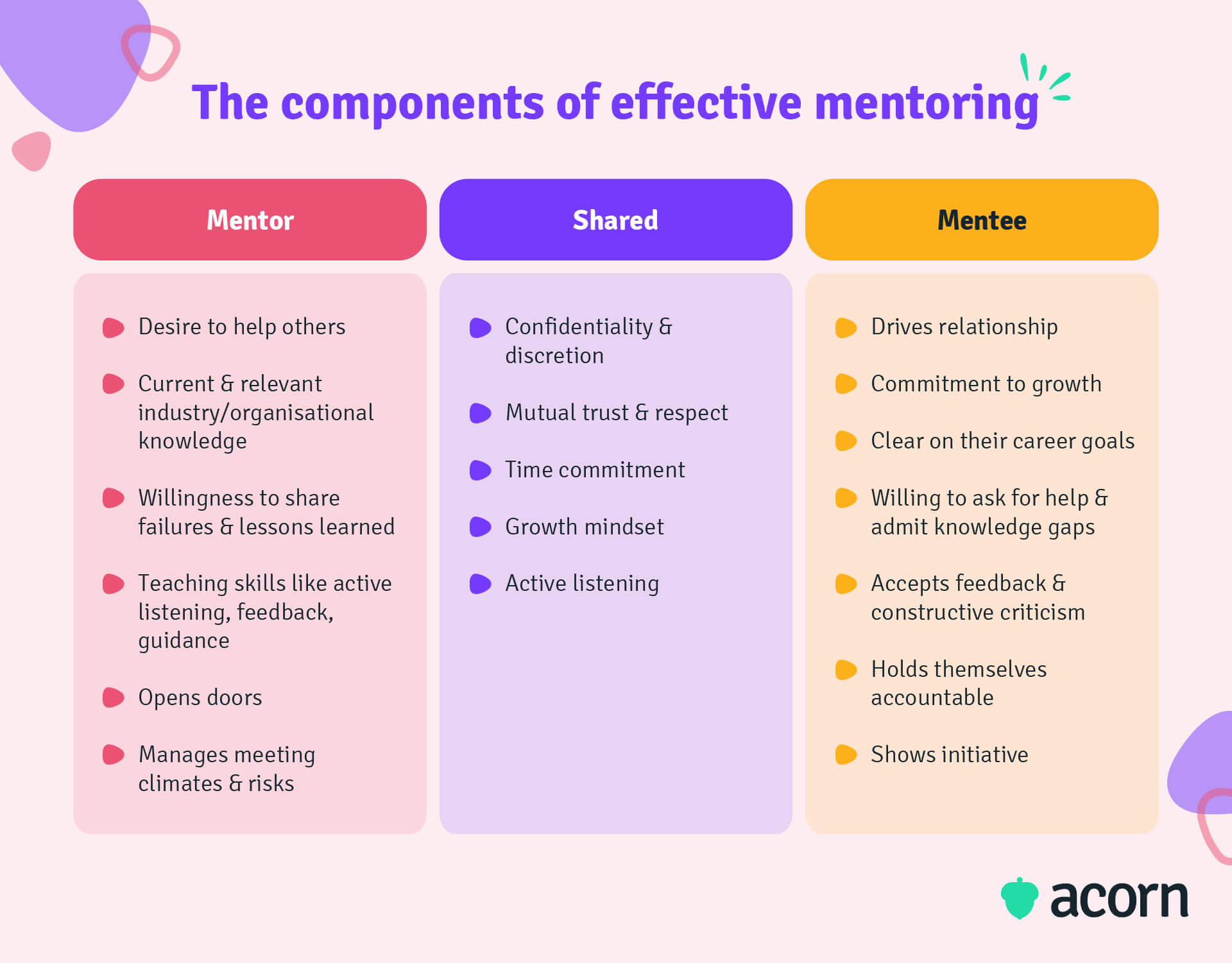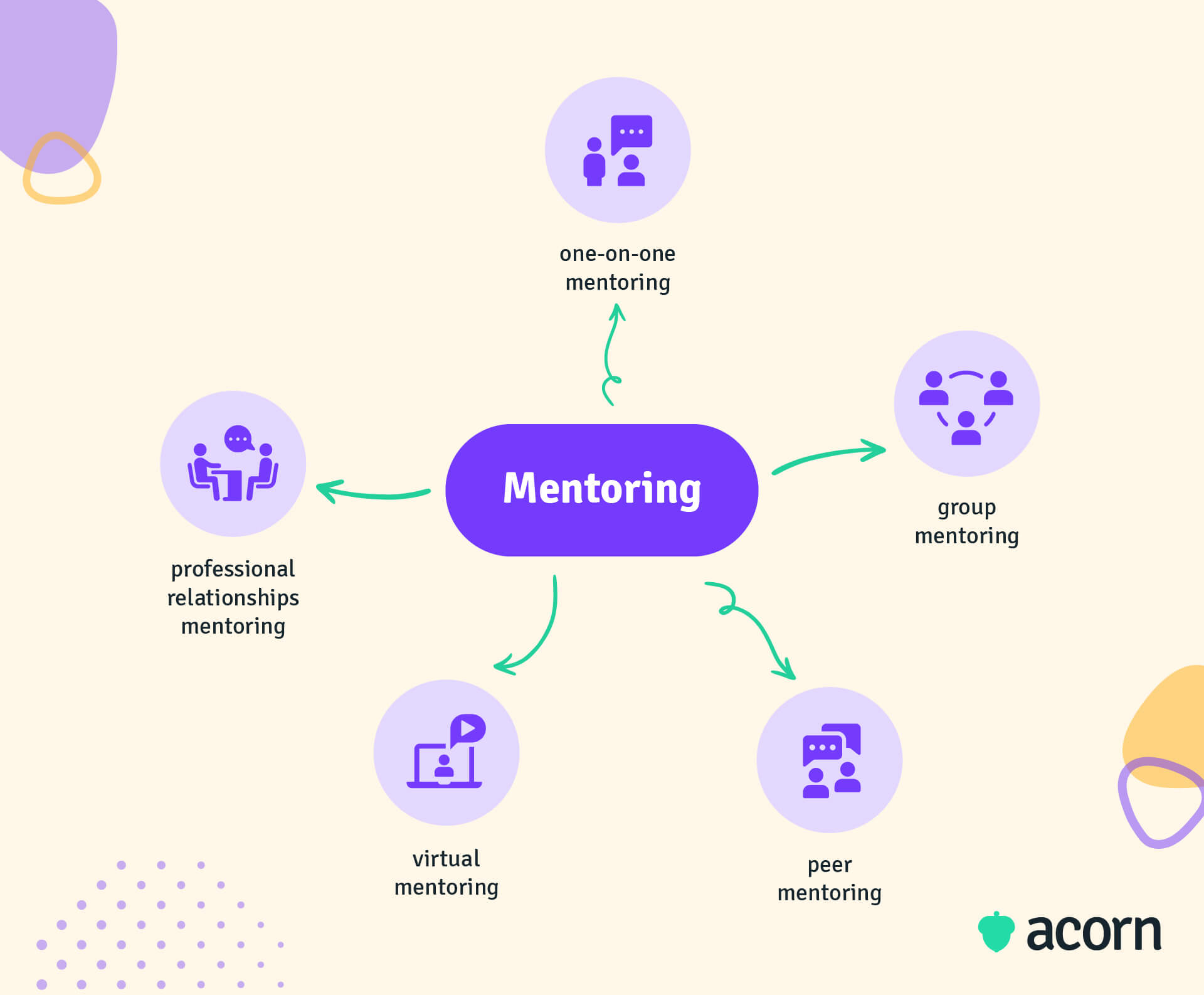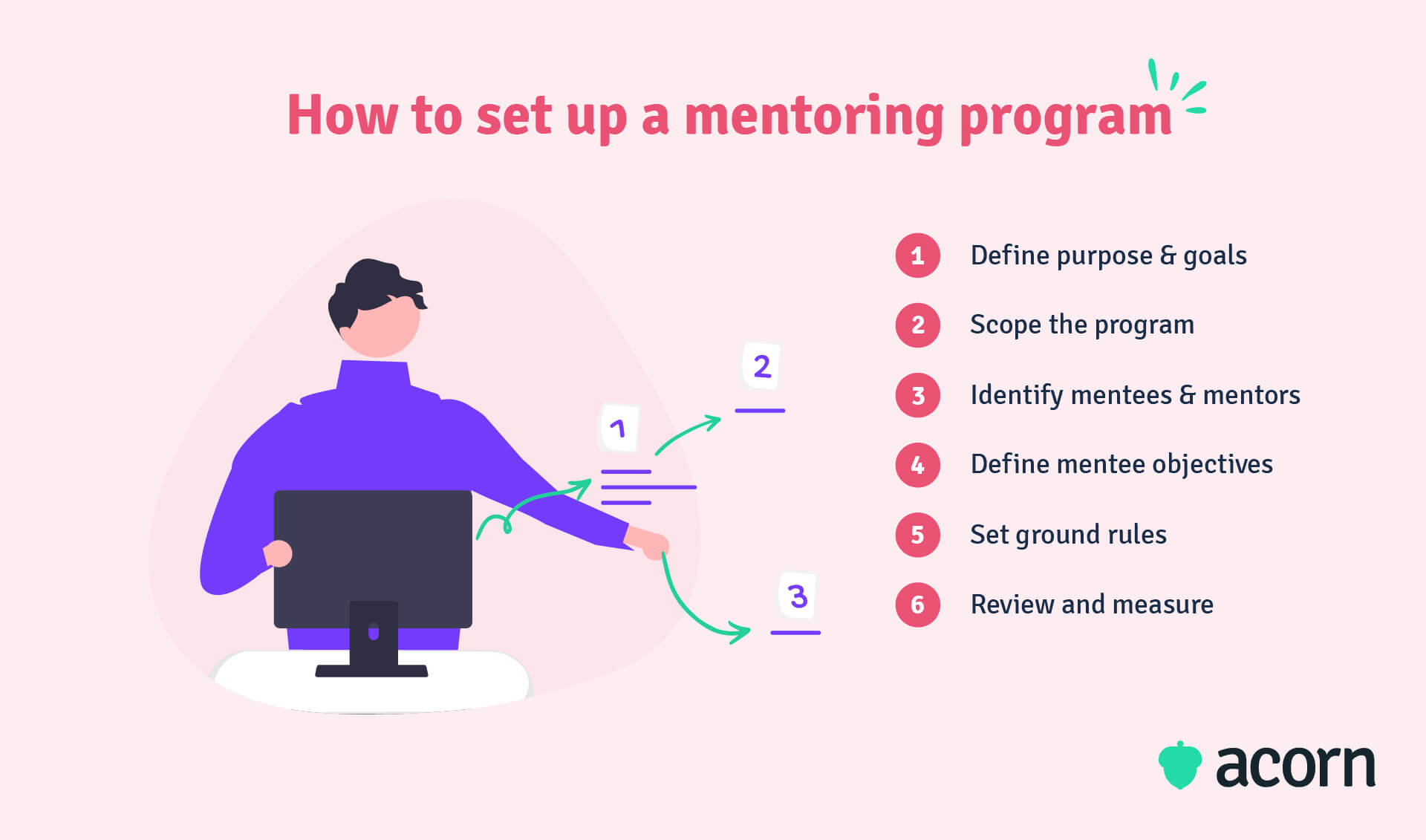The Benefits of Mentoring Employees & Ways to Establish a Mentoring Program
Reading Time:

Lead the pack with the latest in strategic L&D every month— straight to your inbox.
SubscribeYoda and Luke Skywalker. Mr Miyagi and the Karate Kid. Dumbledore and Harry Potter. There’s a reason that fiction’s full of mentor–mentee relationships.
Mentorship is an important learning and development experience for both mentor and mentee. It’s a chance to share and validate business-critical knowledge, advance career pathways, and create networks inside and out of your organisation.
If you’re looking to offer a mentorship program to your employees, you’re in the right place. In this guide, we’ll walk through the benefits of formal mentoring relationships and how to effectively implement a program in your organisation.
What is mentoring?
Mentoring is a mutually beneficial relationship between two people that seeks to impart knowledge with the aim of professional and personal development. The mentor is usually skilled in specific areas of knowledge the less experienced mentee is seeking advice on.
Why is mentoring important?
They say good mentorship is discipline-agnostic. It’s not bound to the boss–employee relationship, but rather mimics that of a parent and child. We’re not saying you have to mother your mentees. It’s about guiding the transition from mentee to mentor, not unlike how a parent helps a child become an adult.
Mentoring isn’t bound to a senior executive–junior associate dynamic, either. Mentorship is based on the premise of sharing experience. Navigating an ever-changing VUCA world (that’s volatile, uncertain, complex and ambiguous to you) requires a blend of hard and soft skills that someone new to the landscape may not know how to harness just yet.
Mentoring:
- Builds a feedback loop
- Advances stalled progression for top performers
- Attracts talent & helps retain high performers
- Provides clarity for career goals
- Better realises employee capabilities
- Develops leadership skills
- Establishes a network.
For those who may not otherwise have a voice, a mentorship program also means multiple perspectives are heard and different solutions are brought to the table. The cascade effects of this are big: Employee engagement and retention spikes, while attrition lowers, as people view the workplace as a place of equal opportunity.

Capturing and operationalising knowledge passed between employees in the flow of work is not something traditional learning solutions can do. That’s why we created the performance learning management system (PLMS). It’s the only solution that links learning experiences to business performance, by a) guiding learners through the capabilities needed to succeed and b) capturing key interactions (read: mentoring) and turning them into shareable learning assets.
The different types of mentoring
There are a few ways to facilitate the mentoring experience beyond a single master and apprentice. It depends on the mentee’s (or mentees’) needs and the resources you have at hand.

One-on-one
The most traditional of all methods, the one-on-one mentoring relationship is exclusively mentee and mentor. Very often, it’s a highly experienced, potentially senior role paired with a much younger individual starting out in their career or looking to transition into a new role.
Group
Group mentoring usually sees one or a few mentors work with a group of mentees. You may know it from youth mentoring programs, but it can be applied in the workplace for “immature” teams who need some nurturing. For example, a smaller team who self-govern without a dedicated team leader.
Peer
Peer mentoring is a bit like a formalised buddy system, if you will. The goal is to provide support and impart team, role or department-based knowledge. Often the shared background or experiences can extend to personal lives, as well as professional, such as new graduates and junior associates.
Virtual
We’d be remiss not to mention distance mentoring, given the new remote and online state of the workforce. This type of mentorship program also allows for relationships across states or even countries, widening the pool of potential mentors and mentees as well as experiences and cultural perspectives.
Other professional relationships
Coaches, trainers and facilitators, and consultants all play different roles in nurturing burgeoning skillsets.
- Coaches look at where you are in your career, where you want to be, and how to bridge the gap in between.
- Trainers and facilitators invariably guide learning sessions with the aim of addressing specific skills and knowledge gaps.
- Career consultants mainly help make job transitions smoother.
The difference between all of these (very valid and useful) roles and a mentor is that the mentor-mentee relationship is usually voluntary, free and often internal. Coaches, facilitators and consultants can be commercial and external relationships cultivated to aid professional development.
The benefits of effective employee mentoring
Effective mentoring relationships are mutually beneficial. Essentially, when done right, mentoring should benefit both employee—aka, the mentee—and mentor.
While mentors can take the opportunity to improve their leadership skills, mentees can enjoy increased job satisfaction. And better yet, the benefits for mentee, mentor and business include:
- Expanded professional networks
- Confidence in their performance
- Fast-tracked career development
- Clearer feedback channels
- Better knowledge sharing
- Enhanced workforce upskilling.
Improve & validate leadership capabilities
Two schools of thought here.
- Leaders aren’t born, they’re developed.
- If you can’t explain something to someone else, you probably don’t understand it well enough yourself.
So, if a measure of competence is knowledge sharing, then mentoring is a great way to develop leadership capabilities. And part of that development is to specifically shape the next wave of leaders in your organisation.
Because a mentee and mentor may not come from the same background, it’s a chance for the latter to hone their communication skills and expand their perspective. Someone with less experience provides a fresh mindset for an established process or may have a different way of learning to the mentor, which forces said mentor to learn to adapt to the varying needs of their teams.
Fast-track career development
Mentorship offers a chance for both parties to advance their careers. For mentors, the aforementioned refining of leadership skills shows initiative and, all going well, can be given as evidence for promotion. It also positions them as advisors for future projects.
For mentees, putting yourself forward for mentorships is a key way to show your interest in progressing within your organisation. Even when moving jobs, it shows a willingness to learn and develop outside the scope of your current role. Self-motivation is highly desirable to employers; it means managers spend less time, well, micro-managing and more time on key business tasks like forecasting and strategy. A mentor also helps mentees stay focused and on track with their personal and professional development thanks to that added external motivation.
Create networking opportunities
At some point, you may have heard someone say it’s not what you know, but who in business. It’s not an entirely out-of-touch concept. Having points of contact you can go to for future advice, endorsement and opportunity is a great way to establish yourself in your industry (and beyond). Mentees get a mentor they can turn to when seeking advice, and both expand their own professional contact books.
This is also helpful for new hires; it can take months to get to know key coworkers (especially if they’re outside your team) and can also be intimidating to reach out without an introduction. It’s even truer in remote working environments. Formal mentoring programs give mentees access to important contacts sooner and without the worry that you’re impeding on someone else’s time.
Boost job confidence
You likely don’t notice the days when you’re soundly fulfilling your job responsibilities, but you’ll remember the ones when nothing makes sense. Up to 82% of people experience imposter syndrome in their jobs and are unable to recognise success when achieved. The endless (and sometimes blind) pursuit of success can lead to stress, burnout and decreased job performance. And when those employees are given more responsibility, their self-doubt increases—meaning your managers aren’t exempt from feeling behind the eight ball.
Mentorships can provide emotional support on top of professional. Alongside showing the lessons in failure, the right mentor can shape a growth mindset in their mentee and empathise with similar challenges they’ve faced. Not only does this contribute to a better workplace culture, but it shapes the next generation of talent and ensures consistent personal development.
Better knowledge transfer
Mission-critical knowledge usually rests within (yes, within) employees, not always documentation. This is a key reason mentorship is an important L&D tool: Without channels for knowledge transfer, you unwittingly create knowledge silos that impacts the workforce’s ability to innovate, problem solve and remain competitive.
More experienced employees (perhaps those considered subject matter experts) will have thorough organisational knowledge from their time on the same or similar career path to a mentee. The mentor–mentee dynamic is an important way to transfer knowledge, since it contributes to:
- Knowledge cascades, or the movement of knowledge from one expert through to multiple employees.
- Transforming the mentee into a mentor for their peers, which boosts social learning.
Enhanced upskilling
You shouldn’t be upskilling for the sake of upskilling. That’s an easy way to waste L&D investments. There should be a purpose, and purpose is something mentoring programs provide.
Most mentees are looking for a guide for their career progression, even if only for a certain phase. Mentors provide that link between learning and application, as well as crucial experiential learning that often only happens on the job. When mentors connect musings and failures to learnings for mentees, it gives them real-world context for their broadening skillsets. This gives your organisation faster time-to-value on performance impacts and employees a chance to develop intrapreneurial mindsets.
How to establish a mentoring program
Implementing a formal mentoring program in your organisation is easier than you think. It involves a lot of crowdsourcing to understand what will be of value to your employees (both mentees and mentors) and creating structured processes that ensure there are achievable outcomes.

Define purpose & goals
Consider your business needs when starting a mentoring program. Is employee engagement low, are talented employees leaving or succession plans hanging in the balance? Your organisational reasons will help keep everyone on track when managing the program.
Identify the motivations for employees in signing up as well. They’ll differ from your organisation’s, in that they’ll give you the value prop to encourage future participation. This way, you can design a program that suits business and workforce needs. What gaps do they want to bridge? What opportunities are they seeking? It may help to look at other learning and development programs you already have in place and solicit feedback from employees on any missing puzzle pieces.
You’ll also want to define successful mentorship at this stage. If your metrics are impacts on engagement rates and succession planning, you could set KPIs like self-confidence (established through self-evaluations) and promotion rates. This goes a long way towards helping program managers reporting on ROI later, which we know can be incredibly important for executives but be notoriously tricky to pinpoint without clear outcomes.
Flesh out the program
There are a few points you’ll want to detail to build out your program.
- Space. How many spaces will be available in a normal run? Will there be a cap?
- Exclusivity. Do employees sign up or can they arrange their own mentors?
- Advocacy. How will sign ups be encouraged? Where will the program be marketed internally? How will you remove barriers to participation?
- Time. How long will each partnership last? Will you structure that as an initiative, or allow mentees and mentors to decide?
- Pairings. What system will you use to match mentors and mentees?
- Format. What types of mentorships are appropriate for your needs?
You may only want one-on-ones, or it might be necessary to have virtual and peer mentoring programs. Whatever you choose, it should match the needs of your employees. That could be any (or none) of the following:
- Peer mentoring as part of onboarding
- One-on-one job shadowing for leadership succession
- Group mentoring with an industry vet for a team who ordinarily self-manage
- Virtual mentoring to connect local sales roles with global BDMs.
Identify mentors & mentees
It’s a good idea to create a list of mentors and mentees in waiting. Using some kind of software is best for this, so that no one can be accused of playing favourites or wasting time on manual matchmaking.
Mentors
Look to those who are not only in leadership positions, but clearly display your desired leadership capabilities. They need to be clear and respectful with how they discuss any issues, so that mentees feel comfortable raising concerns.
Assigning immediate supervisors as mentors isn’t a good idea for this reason; the point is to create a psychologically safe space for mentees to discuss skills gaps that aren’t being addressed in their current work environment. Mentors shouldn’t be sugar coating things. Spotlighting weaknesses (as opportunities for deep thinking or learning) and providing constructive critique is what makes for an effective mentor.
Mentees
Performance evaluations, skills gap analyses and discussions with managers are a good way to find out who will benefit most from a formal mentoring relationship. It’s a great way to show you’re invested and investing in your employees’ individual needs.
Mentees should know what they want to accomplish from their mentorship. Accountability lies with them, not the mentor, to ensure they are clear on what the mentorship means to them.
As an aside, don’t stop employees from seeking their own mentors out. They may have a contact or respected professional outside your organisation with a different skillset than is available to them internally. This is a good chance for your organisation to build a network of subject matter experts for future mentees. It also builds those new, unexplored skillsets within your organisation, so that the current mentee can pass that knowledge on as they become a mentor.
Define mentee objectives
A successful mentoring relationship begins with a shared goal-setting session. A mentee should have expectations of what they are looking for, and the mentor can give credence to those goals or flesh out new ones they believe are beneficial. This guides the agenda of meetings going forward and provides a clear shared sense of purpose.
It’s also a chance for mentors to validate their knowledge and experiences against outcomes. This saves time later, if the time investment doesn’t match not only what the mentee needs, but what each can bring to the partnership. It also helps maintain momentum, with a regular reminder of what both parties are trying to achieve.
Set it in stone
You can formalise goal setting with written agreements or action plans that require your pairs to list objectives and tasks. Both the mentor and mentee must sign off on each point when they believe it’s been achieved for the mentorship to proceed or end.
Set ground rules
Having rules for interaction helps guide the path ahead. Between mentee and mentor, this can include:
- Each role’s responsibilities to the other
- Each person’s role in sustaining the relationship
- How they’ll work together towards shared goals
- When and where to meet
- Channels/methods of communication outside face-to-face meetings.
Giving mentors in particular control over their part of the process ensures buy-in. They likely have busy schedules and forcing them to divert time away from their projects isn’t the way to keep them invested. It also means they can set logistical details that suit them. Similarly, mentees gain a sense of ownership over their career development.
Set it in stone
Scheduling pre-program and review meetings can help ensure there’s clarity for all involved—including your HR arm or whoever is responsible for organising your programs. Knowing how long a partnership will run for helps with planning for other projects and future mentorship programs.
Review and measure
You need to continually measure the dynamics and structures between mentors and mentees. This way, you can make changes as needed, both to partnerships and the structure of the program.
Keep the feedback from mentors and mentees separate. A third party, like an HR administrator, should be responsible for seeking feedback at regular intervals. Depending on the length of the mentorship, this could be anywhere from monthly to annually.
Set it in stone
Surveys through tools like your learning management system (LMS) help centralise feedback and meaningful metrics. You could also utilise questionnaires and interviews to understand knowledge transfer, impact on job performance, and value add for mentors and mentees.
3 common mentoring pitfalls to avoid
Why do some mentoring programs fail? It’s no mystery. It really comes down to now following the tenets you set out. Three reasons mentoring programs hit the skids before even really taking off are:
- No or poor training
- Strange pairings
- Not holding to structure.
Lack of training
Research has shown that only 1 in 3 mentoring relationships succeed without training. While you can impress on mentors and mentees the behaviours and attitudes of good mentors and mentees, it’s better to give them the tools and resources to reinforce this because not everyone is a natural mentor.
LMS modules can address the problem of distance if you have a geographically dispersed (or working from home) workforce. This gives your organisation the added benefit of being able to gauge engagement rates and progress, and mentors and mentees the convenience of accessing training whenever they can.
Poor matches
We’ve covered the main way you can avoid a poor match through technology. But without a plan, what makes a good match can still seem a little murky. Matching personalities are “too similar” can lead to a certain familiarity that may limit the potential for learning. Without some challenge, mentorships risk being uneventful.
Instead of looking too closely at personalities, look for common ground. That could be having children of similar ages, both being women, or being just a few years apart in their careers. Common ground helps build rapport and helps avoid obvious mismatches. A senior executive with grown children approaching retirement might not be the best match for someone with a year’s experience and no dependants.
Skipping milestones
Those aforementioned objectives exist for a couple of reasons:
- It gives a sense of beginning, middle and end. Think about any projects you’ve worked on in the past; surely it helped to know where your deadlines were. Timeframes give a sense of satisfaction.
- There are opportunities to flag dissatisfaction. Surveys, check ins, even just open discussions to talk about what’s working (and what’s not) for both mentee and mentor helps to avoid resentment.
- It keeps everyone abreast of their responsibilities. Without having commitments set in stone, it can be easy to a) forget them or b) wilfully ignore them (we’ve all procrastinated). It also ensures the mentee is driving the relationship—as they should be.
Key takeaways
Mentoring is a long-used practice of sharing invaluable knowledge within an organisation. It’s so oft-used because it helps build inclusion, increase time-to-value with onboarding, improve employee engagement and overall create a more connected company culture.
Mentoring programs help:
- Build feedback loops
- Advance stalled progression for top performers
- Make clear career goals
- Better realise existing leadership capabilities
- Establish professional networks that ultimately aid your organisation.
It’s not always a one-on-one or inter-organisation relationship. Group mentors can help nurture small teams, while peer mentoring is a way great way to build coworker relationships during onboarding. Virtual mentorship means those working from home aren’t sidelined and gives you the opportunity to create a network of mentors outside the limits of your organisation’s capabilities.
Establishing a mentoring program begins with:
- Defining organisational objectives
- Scoping champions, format and admission
- Identifying mentors and mentees
- Defining mentee goals
- Setting rules for play
- Reviewing and measuring success.
Sticking to a well-formulated program helps you avoid some common pitfalls that cause many programs to fail. Ensuring you give participants resources to support their involvement, make shrewd pairings and keep everyone on a checklist will offer your organisation the highest chance of mentoring success.